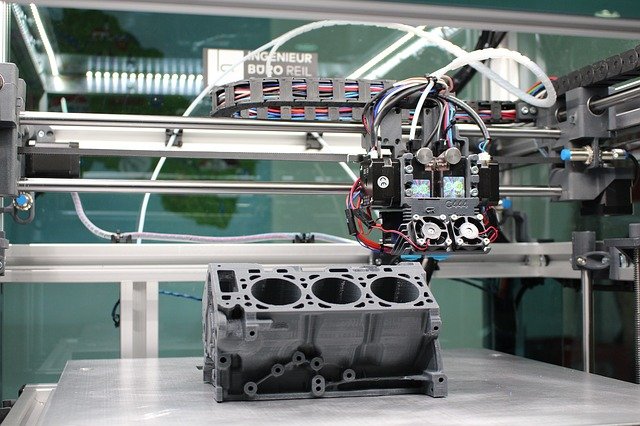
The Evolution of Engineering
The Fourth Industrial Revolution - New Chances for Engineers
Read a summary using the INOMICS AI tool
Ever since Klaus Schwab, the Founder and Executive Chairman of the World Economic Forum coined the phrase “Fourth Industrial Revolution” in his 2016 book, technologists and engineers have been getting to grips with what it is, and what role they will play in it. In the book, he describes it as a technological revolution where the lines between the physical, digital and biological worlds become blurred. In other words, how innovations like the Internet of Things, artificial intelligence, quantum computing etc. interface and merge with our physical existence.
Impact of Previous Industrial Revolutions
To understand the potential of the Fourth Industrial Revolution, it is worth quickly noting the impact of the previous three.
The First Industrial Revolution took place in the second half of the 18th century and revolved around the major invention of the steam engine in Britain. This facilitated the move from small-scale products, made by hand at home or in shops, to larger-scale mechanised production in factories. It also spurred on the growth of factories and the movement of people from rural to urban areas. The ideas and techniques quickly spread to Europe, the USA and beyond, and collectively drove the expansion of textiles manufacturing, cotton gin, steam, coal and iron production, and printing processes to name but a few.
The Second Industrial Revolution, sometimes referred to as the technological revolution, started around the mid-19th century and continued until World War I in 1914. It encapsulated the period where innovations in steel production, telephony, electricity and petroleum led to large-scale electrification and mass-production assembly lines. This further led to the expansion of railroads, the development of heavy industrial machines and the introduction of cars and airplanes.
It wasn’t just the technology that was changing; industries were being driven by new organizational models and production processes, perhaps most famously championed by Henry Ford. He developed the assembly line production for his cars, dramatically increasing output and creating efficiencies which were copied in other sectors – and still in use today.
The Third Industrial Revolution or digital revolution began around the 1950s and saw the fundamental change from analogue to digital. Inventions, including the microprocessor chip, semiconductors, electronics, mobile communications, personal computers and the internet, transformed most spheres of business, industry and home life. These changes further fuelled innovations in engineering techniques and materials, automation of industrial processes and supply chains – it changed business models paving the way for mass globalisation.
The common thread that runs through these three revolutions is that all included inventions of a new technology or process that profoundly changed how humans worked and lived. And so it is with the Fourth Industrial Revolution – or as it is sometimes known, 4IR or Industrial 4.0.
Fusion of Physical, Digital and Biological Worlds
The fusion of the physical, digital and biological worlds envisioned within the Fourth Industrial Revolution will create irreversible and transformative changes in the way humans live, work and play - and disrupt almost every business / industry / engineering sector in the process. It also creates opportunities for both existing engineers and people starting out in their engineering careers to be the drivers of innovation, creating new inventions and delivering solutions to pressing global challenges.
Suggested Opportunities
- Conference
- Posted 1 week ago
19th RGS Doctoral Conference in Economics - Fiscal Challenges
Between 18 Feb and 19 Feb in Bochum, Germany
- Workshop, Conference
- Posted 1 week ago
Venice Summer Institute
Between 22 Jun and 25 Jun in Venice, Italy and Venice, ItalyThere are already practical applications that engineers are getting to grips with. There will be a convergence of previously diverse fields, such as artificial intelligence, big data, the Industrial Internet of Things, biomedical engineering, materials science and machine learning. This convergence is already leading to significant advances in many areas.
Practical outcomes of these advances will include more (and more intelligent) automation in industry and manufacturing, and more connectivity between these fields and business. It will lead to smarter buildings and factories, for instance, and further developments in, and an increasing application of, intelligent materials.

For example, aerospace engineers are already benefiting from developments in robotics and nanotechnology. Engineers in many fields are involved in both the development of, and increasingly benefitting from the application of autonomous vehicles and 3D printing. And the current focus for environmental engineers on efficient energy storage extends to many areas, from its obvious importance for the renewable energy sector to the oil and gas and marine engineering sectors.
Other opportunities include improvements in manufacturing operations. For example mechanical engineers will be able to improve and automate the maintenance of plants and equipment using sensors and digital technologies. Big data will enable a better design and development of global supply chains. Within healthcare, patients will share their medical records via wearables and doctors will be able to identify risks early and make assessments in real-time. In retail, customers will receive a more customised service from shops and online merchants with targeted marketing powered by AI, and VR salespeople making knowledgeable recommendations.
Impact on Engineering and Engineers
As readers will recognise from these examples, the Fourth Industrial Revolution is already here, and evolving at an exponential rate. And as we have seen, it touches (or will touch) every aspect of industry, business and home. One of the biggest challenges the engineering sector thus faces is to recognise to what extent it already has the skills needed to play a meaningful role in 4IR, and to what extent it needs to evolve as a discipline.
As with previous industrial revolutions, some jobs, including engineering jobs, will disappear and new ones will emerge – implying that a new set of skills will be required. It is important to note that engineers will always be required - any evolution of robotics, AI, IoT, VR or other technology is predicated on human (engineering) involvement. So until the day that robots can create other robots (!), engineers will always be needed. Having said that, the skills engineers need will to a large extent be different from today.
While “traditional” engineering skills like complex problem solving and collaboration will be crucial for engineers taking part in 4IR, a key change will be the focus on creativity and design. With a lot of production processes (in manufacturing and construction for example) being automated, there is an increasing need for new engineers to focus on the design element, and particularly creative design. An extension of that is the multidisciplinary nature of engineering going forward – adding in art, emotional intelligence and decision making to meet the needs of new jobs.
Whether it is generating new sustainable power technologies or constructing sensors and connecting nanotechnologies for new applications, or inventing bionics with intelligence, the skill set required of engineers in the future will be different from that required in the past. In the process, changes to engineering education, for example the focus of engineering masters programs or engineering PhDs will need to be realigned, to train engineers with skills relevant to the future workplace. Engineering talent acquisition will also need to evolve – we know there is a shortage of engineers already and with a skill shift likely in the near future, engineering has a recruitment challenge on its hands.
Fifth Industrial Revolution
Whilst it is true that we are now living through the Fourth Industrial Revolution (and have been for a while), we may be on the cusp of the Fifth Industrial Revolution (5IR). Indeed, it may be that these two will overlap for several years.
Defining what 5IR is (and is not) is difficult in itself, but experts are recognising that whilst 4IR is about technology and innovation, 5IR will be about the combination of humans and machines.
This creates its own challenges – how will humans interact with machines and with each other? What role will ethics play in applying emerging technologies? And indeed, do we have the engineering knowledge and skills needed to guide and manage the revolution itself? These questions will have to be answered pretty soon if we are to not only fully exploit 4IR but be prepared for 5IR.
NewEngineer and our parent company INOMICS are Amazon Associates, meaning we are a part of their affiliate program. This article contains affiliate links, which means we may earn money through any qualifying purchases made after you click through. However, this is not a sponsored post.









